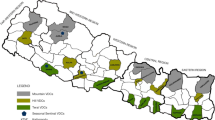Abstract
Background: Early introduction of cow’s milk is a risk factor for the development of anaemia and iron deficiency, which is associated with lower childhood developmental scores. The objective of this paper is to describe the incidence of the introduction of cow’s milk before the recommended age of nine months and factors associated with early introduction.
Methods: Mothers of healthy term infants were invited to take part in the Infant Feeding Survey in 2002–2003. These mothers, from Southern Ontario, were interviewed by telephone at three and nine months postpartum to determine infant feeding practices.
Results: One in eight (12.7%) mothers completing the second interview indicated that they were feeding their infant non-formula cow’s milk as the primary source of milk before nine months. Multivariate logistic regression analysis showed that mothers feeding cow’s milk before nine months were younger, lived in households with lower annual incomes, and were less likely to have attended prenatal classes or to recall receiving information on the introduction of solid foods. They were also more likely to have introduced solid foods or skimmed milk before the recommended ages.
Conclusion: A substantial proportion of Southern Ontario infants are receiving cow’s milk before the recommended age, putting them at increased risk for iron deficiency and the resulting sequelae. Further research into why guidelines are not followed is indicated.
Résumé
Contexte: L’introduction précoce du lait de vache est un facteur de risque lié à l’anémie et à la carence en fer, lesquelles sont associées à de moins bons indices de développement du jeune enfant. Nous avons voulu décrire l’incidence de l’introduction du lait de vache avant l’âge recommandé de neuf mois et les facteurs associés à son introduction précoce.
Méthode: Nous avons invité les mères de nourrissons en bonne santé nés à terme à participer à l’enquête Infant Feeding Survey en 2002–2003. Ces mères, qui habitent le Sud de l’Ontario, ont été interviewées par téléphone trois et neuf mois après l’accouchement au sujet de l’alimentation de leur nourrisson.
Résultats: Lors de la deuxième entrevue, une mère sur huit (12,7 %) a déclaré que le lait de vache (non offert en préparation lactée) était la principale source de lait de son nourrisson avant neuf mois. Une analyse de régression logistique multivariable a montré que les mères qui nourrissaient leurs bébés de moins de neuf mois au lait de vache étaient relativement jeunes, qu’elles vivaient dans des ménages dont le revenu annuel était relativement faible, et qu’elles étaient moins susceptibles d’avoir assisté à des rencontres prénatales ou de se rappeler avoir reçu de l’information sur l’introduction des aliments solides. Elles étaient aussi plus susceptibles d’avoir introduit les aliments solides ou le lait écrémé avant l’âge recommandé.
Conclusion: Une proportion importante de nourrissons du Sud de l’Ontario sont nourris au lait de vache avant l’âge recommandé, ce qui accroît leur risque de présenter une carence en fer et ses séquelles. Il faudrait pousser la recherche sur les raisons de la non-observance des lignes directrices.
Similar content being viewed by others
References
Canadian Paediatric Society, Dietitians of Canada, and Health Canada. Nutition for healthy term infants: Statement of the joint working group. H39-153/1-198E. Ottawa, Ontario, Minister of Public Works and Government Services, 1998.
Daly A. Prevention of anaemia in inner-city toddlers by the use of a follow-on formula. Professional Care of Mother and Child 1997;7(5):141–42.
Gill DG, Vincent S, Segal DS. Follow-on formula in the prevention of iron deficiency: A multi-centre study. Acta Paediatr 1997;86(7):683–89.
Willows ND, Dewailly E, Gray-Donald K. Anemia and iron status in Inuit infants from northern Quebec. Can J Public Health 2000;91(6):407–10.
Faldella G, Corvaglia L, Lanari M, Salvioli GP. Iron balance and iron nutrition in infancy. ACTA Paediatric Supplement 2003;91(441):82–85.
Lozoff B, Jimenez E, Hagen J, Mollen E, Wolf AW. Poorer behavioral and developmental outcome more than 10 years after treatment for iron deficiency in infancy. Pediatrics 2000;105(4):E51.
Kazal LA. Prevention of iron deficiency in infants and toddlers. Am Fam Phys 2002;66(7):1217–24.
Pan American Health Organization. Guiding principles for complementary feeding of the breastfed child. 2003. Washington, DC: World Health Organization.
American Academy of Pediatrics. Breastfeeding and the use of human milk (RE9729). Pediatrics 1997;100(6):1035–39.
Freeman V, Hof M, Haschke F, Euro-Growth Study Group. Patterns of milk and food intake in infants from birth to age 36 months: The Euro-Growth study. J Pediatric Gastroenterology and Nutrition 2000;31(S1):S76–S85.
Savage SJ, Reilly JJ, Edwards CA, Durnin JV. Weaning practice in the Glasgow Longitudinal Infant Growth Study. Arch Dis Childhood 1998;79:153–56.
Ummarino M, Albano F, DeMarco G, Mangani S, Aceto B, Ummarino D, et al. Short duration of breastfeeding and early introduction of cow’s milk as a result of mothers’ low level of education. ACTA Paediatric Supplement 2003;441(S):12–17.
Giovannini M, Riva E, Banderali G, Scaglioni S, Vehof S, Sala M, et al. Feeding practices of infants through the first year of life in Italy. Acta Paediatr 2004;93:492–97.
Lande B, Andersen LF, Baerug A, Trygg KU, Lund-Larsen K, Veierod MB, et al. Infant feeding practices and associated factors in the first six months of life: The Norwegian Infant Nutrition Survey. Acta Paediatr 2003;92:152–61.
Canadian Intergovernmental Conference Secretariat, editor. First Ministers’ Meeting Communique on Early Childhood Development. First Ministers’ Meeting; 00 Oct 11; Ottawa: 2000.
Stata Statistical Software: Release 8.0. College Station, Texas: Stata Press, 2003.
Author information
Authors and Affiliations
Corresponding author
Rights and permissions
About this article
Cite this article
Coleman, B.L. Early Introduction of Non-Formula Cow’s Milk to Southern Ontario Infants. Can J Public Health 97, 187–190 (2006). https://doi.org/10.1007/BF03405581
Received:
Accepted:
Published:
Issue Date:
DOI: https://doi.org/10.1007/BF03405581




